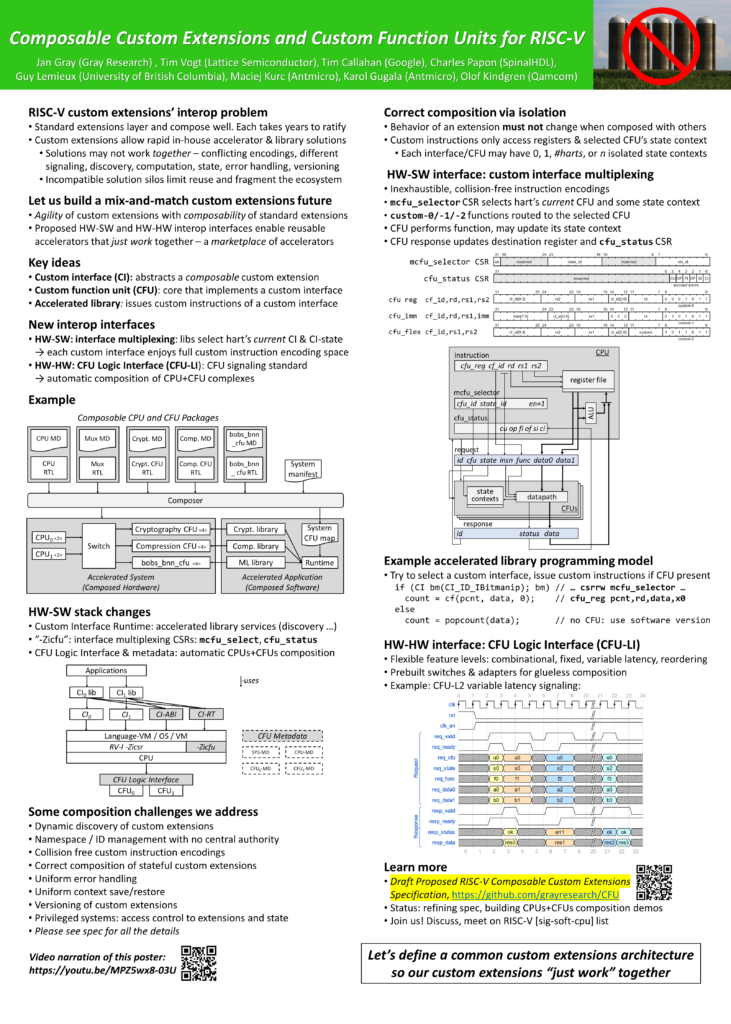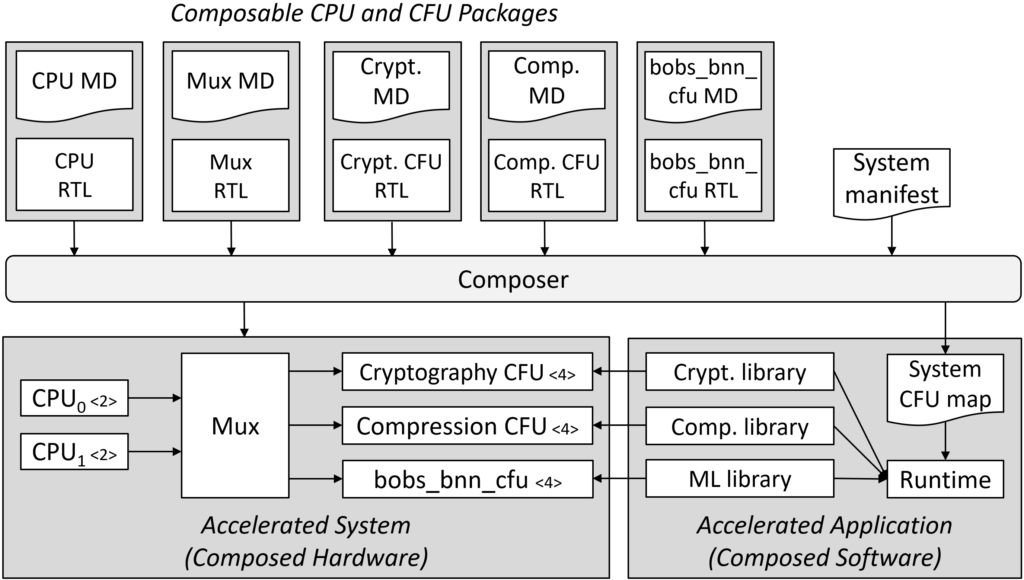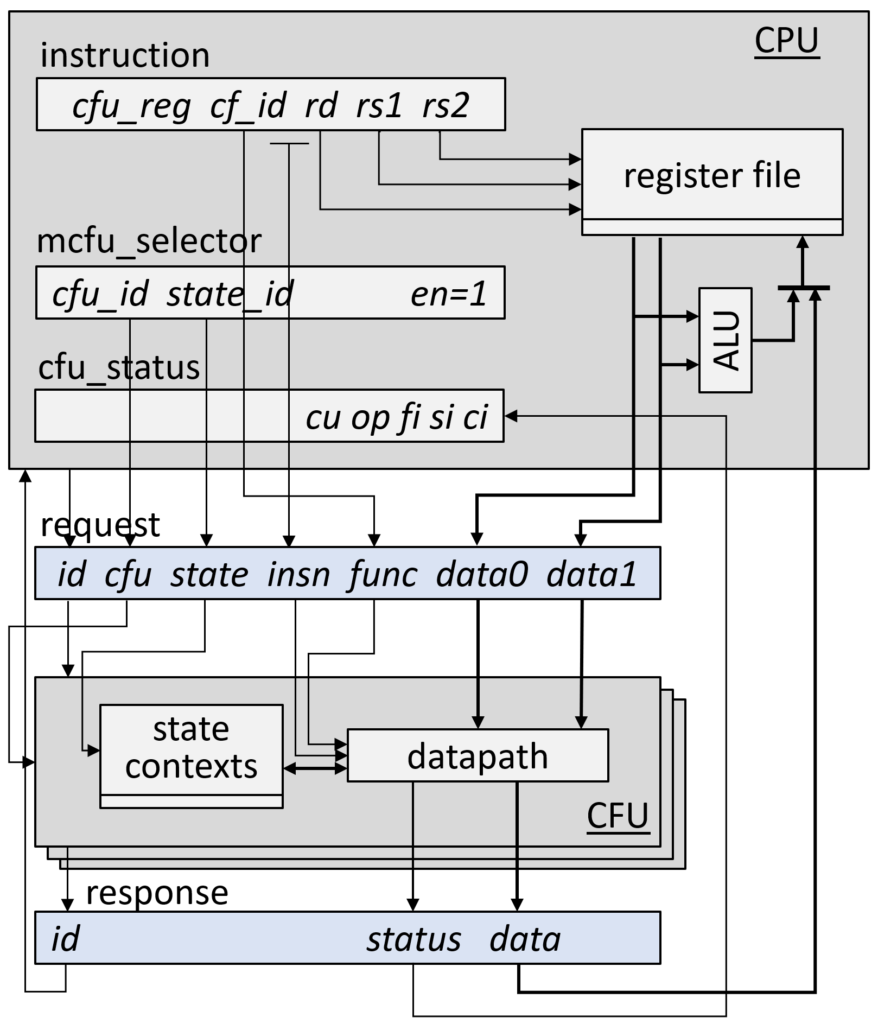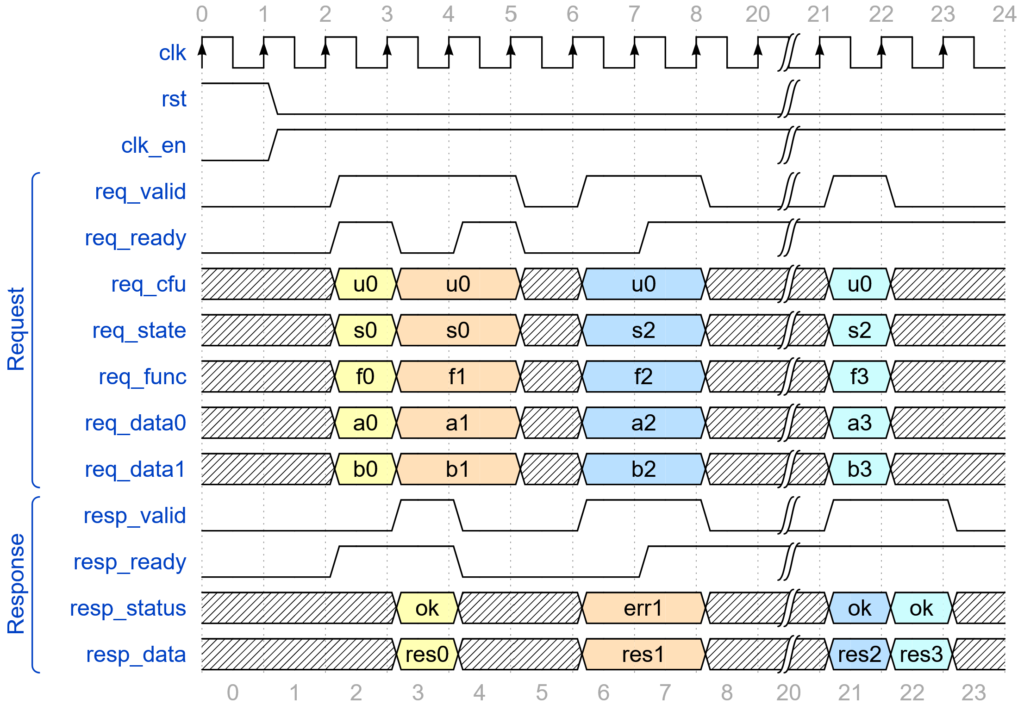In winter 2022 I reworked our 2019-2022 work-in-progress materials on RISC-V Composable Custom Extensions into the Draft Proposed RISC-V Composable Custom Extensions Specification.
We presented a poster (narration) on this work at the 2022 Paris RISC-V Summit. Then we stepped back, to work elsewhere, and waited to see if there were new interest or uptake in the work. Some but no groundswell!
I did some development work towards that first still-pending end-to-end composition demo. I added some example CFUs to the nascent CFU Zoo, including implementations of the three CFU-LI level adapters and a CFU Switch.
In June 2023, my colleague, Prof. Guy Lemieux of UBC, chair of the RISC-V International SIG-SOFT-CPU group, and another co-designer of the composable extensions work, presented a new talk From CCX to CIX: A Modest Proposal for (Custom) Composable Instruction eXtensions at the 2023 Barcelona RISC-V Summit.
SIG-SOFT-CPU was one the original RISC-V Foundation SIGs. In 2019 our focus (and teleconf meetings) gradually devolved to strictly focus on refining the composable custom extensions work and so the other SIG charter items received short shrift. With the transition to RISC-V International, SIG-SOFT-CPU went dormant, but now in summer 2023, Guy is working to reboot the SIG. Currently he is driving a process to ratify a new Charter for the SIG.
The great big rename: goodbye Custom Interfaces and Custom Function Units (CFUs), hello Composable Extensions and Composable Extension Units (CXUs)!
For better or worse, the Custom Extensions spec has always used the invented, defined term Custom Interface to mean the abstract immutable interface contract of a composable custom extension. From the beginning I used this term because 1) it shone a spotlight on the all-important interface contract aspects of a custom extension, and 2) as homage to its inspiration, Microsoft COM Interfaces. Unfortunately it has only sowed confusion, between terms Custom Interface and Composable Extension, particularly because the spec also uses the (separate) concept interoperation interface extensively.
At last week’s online meeting I gave a 45 minute deeper dive into Composable Extensions for the SIG-SOFT-CPU members. When prepping for this talk, and giving it, I was frustrated that these particular monikers were not helping to convey concepts and understanding. It was time to say goodbye to custom interface. We needed a new term (not custom extension) to distinguish the category of composable custom extensions from current non-composable custom extensions and I chose composable extension for short.
This anticipates a RISC-V ISA world with standard extensions, composable extensions, and custom extensions; CX ::= composable extension.
Similarly we need a crisp term for the reusable modular hardware unit that implements a composable extension. Years ago I coined the term custom function unit for this type of tightly CPU-coupled synchronous hardware unit, because it implements the custom function instructions of composable custom extensions. But CFU is no longer apt and ideal. For one thing, an early fork of our group’s CFU and CFU logic interface design have become extensively used in the CFU Playground work. It seems tiring, hopeless, and pointless to try to wrest back the CFU moniker imprimateur from the CFU Playground folks for the present composition focused work.
Thus throughout the spec custom function unit (CFU) becomes composable extension unit (CXU). This is appealing because it captures its relationship to CXs: a composable extension unit is a core that implements a composable extension. Perfect. Also, and I can’t explain why, for me, CXU suggests a core that is different more flexible and powerful than a mere CFU. (Beyond older CFUs, proposed CXUs enable uniform/automatic: composition, n state contexts, OS context switching, multicore CPU complexes, extension versioning, …)
Now with the spec thoroughly reworked it was also time to rework the talk.
New talk: Design and Rationale of the Draft Proposed RISC-V Composable Custom Extensions Specification
Here is our new talk Design and Rationale of the Draft Proposed RISC-V Composable Custom Extensions Specification (slides PDF) which explains why RISC-V needs standards-based composable extensions to bring order and reuse to the custom extensions wild-west. The talk details the design of the various interop interface standards proposed in the spec, and importantly, explains why they are they way they are.
I hope you enjoy it, and find it a helpful complement to the spec.
The last slide, our Call to Action, proposes the next step in the work, which is, working with the RISC-V International framework, that the SIG-SOFT-CPU SIG should sponsor two new RVI Task Groups, an ISA TG to standardize -Zicx (custom extension multiplexing) and a non-ISA TG to standardize CXU-LI (custom extension unit logic interface).
Onwards!




